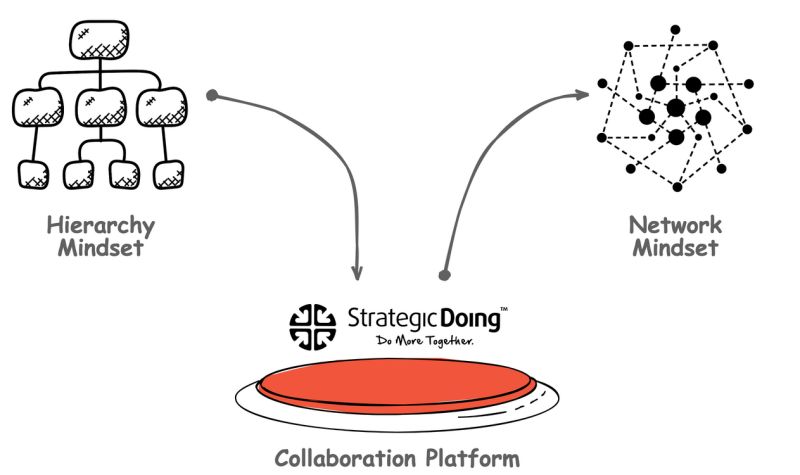Strategic Doing and Positive Deviance
In a turbulent world, strategy becomes everyone’s business. Effective strategy requires us to link, leverage, and align resources to achieve shared outcomes. Collaboration can create new solutions to wicked problems. But we often face an obstacle: fear.
Moving from hierarchical mindsets — which emphasize protecting boundaries and routines– to network mindsets — which emphasize strengthening connections and flows — often triggers fear. And fear freezes us.
Strategic Doing workshops can help.
STRATEGIC DOING AND POSITIVE DEVIANCE
Strategic Doing aligns closely with a logic of social change called positive deviance.
The concept emerged from child nutrition and public health in the 1970s. Practitioners identified the idea and then replicated it in several settings in the 1990s to improve child nutrition.
In many communities of at-risk populations with malnourished children, a few individuals (positive deviants) followed unusual and beneficial practices to achieve better outcomes (Zeitlin, 1991; Marsh et al., 2004; Pascale et al., 2010).
DIG DEEPER: BEHAVING OUR WAY TO NEW WAYS OF THINKING
An important insight emerged from this work:
Behaving differently in front of peers is the most efficient way to introduce new ways of thinking into a community.
This approach suggests that people inside an organization or a community can act their way into new ways of thinking (Pascale et al., 2010).
Research supporting positive deviance, primarily in organizations, is continuing to develop. At the same time, it has potentially useful lessons for organizations and for promoting more extensive social changes (Sternin & Choo, 2000; Mertens et al., 2016; Albanna & Heeks, 2019).
RESOURCES:
Albanna, B., & Heeks, R. (2019).Positive deviance, big data, and development: A systematic literature review. The Electronic Journal of Information Systems in Developing Countries, 85(1), e12063.
Marsh, D. R., Schroeder, D. G., Dearden, K. A., Sternin, J., & Sternin, M. (2004). The power of positive deviance. BMJ, 329(7475), 1177-1179.
Mertens, W., Recker, J., Kohlborn, T., & Kummer, T. F. (2016). A framework for the study of positive deviance in organizations. Deviant Behavior, 37(11), 1288-1307.
Morrison, E. (2022). “Three Stops on Our Journey to Factory 4.0”. Keynote, Factory 4.0 Annual Meeting. Bucharest Romania, (November 9, 2022).
Morrison, E. (2021). Strategic Doing: A Strategy Model for Open Networks (Doctoral dissertation).
Morrison, E. et al. (2019). Strategic Doing: Ten Skills for Agile Leadership (Wiley).
Pascale, R. T., Sternin, J., & Sternin, M. (2010). The power of positive deviance: how unlikely innovators solve the world’s toughest problems. Harvard Business School Press.
Sternin, J. & Choo, R. (2000). The power of positive deviancy. Harvard Business Review. 78(1). 14-15.
Zeitlin, M. (1991). Nutritional resilience in a hostile environment: positive deviance in child nutrition. Nutrition Reviews, 49(9), 259-268.


The Founder of the Lab at UNA and co-author of Strategic Doing: 10 Skills for Agile Leadership, Ed’s work has focused on developing new models of strategy specifically designed to accelerate complex collaboration in networks and open innovation. He is the original developer of Strategic Doing.
